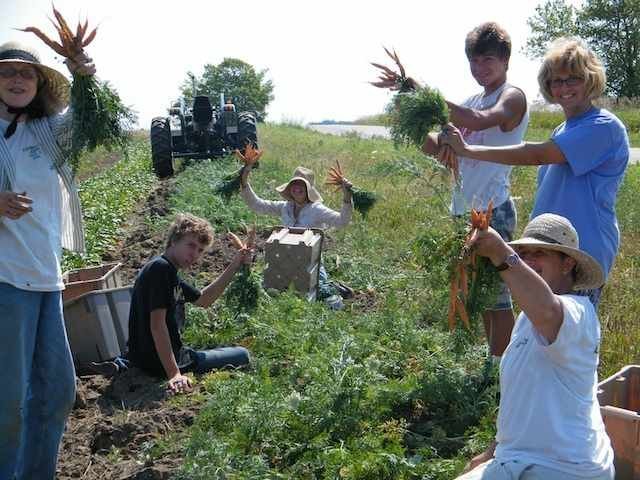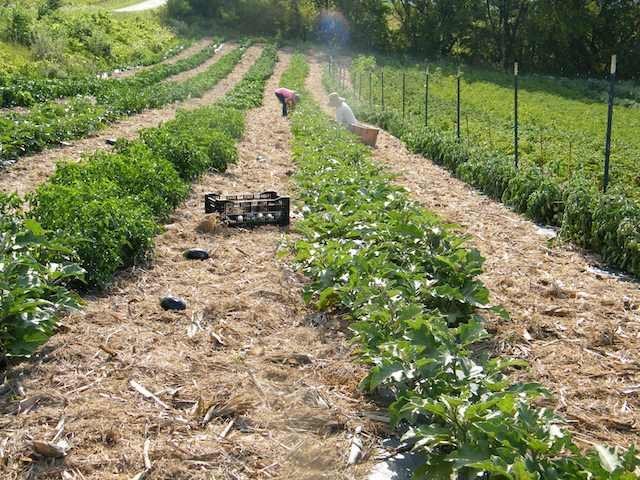
A blessed 1/2 inch of rain fell on our farm early Sunday morning. While the farm is now on life support (irrigation), it gave us a reprieve from the hustle of filling the irrigation tank, laying out lines and pumping the water. The stress-o-meter went down a couple notches Sunday morning and our hope was renewed. But just because a measly half inch of rain came and teased us, we are far from being in the clear. In a perfect year (which never comes) and under perfect conditions (which never happens) 1 inch of rain per week in the months of May, June, July and August would provide the vegetables with ideal soil moisture to keep the blossoms from drying up, nutrients available to the plants and the soil soft enough that their little roots can stretch and grow providing yet more energy to the leaves and fruits of the plants. In the last six weeks, we have received 2 inches of rain coupled with blazing temperatures in the high 80’s all the way up to the triple digits. If you haven’t heard yet, we are suffering through an extreme drought.  Happy Hands Harvesting Carrots!
Happy Hands Harvesting Carrots!
Someone once pointed out to me how highly unsustainable growing vegetables really is. Truthfully, I do not like to admit this fact and it is scarcely a good marketing tactic to explain this to our faithful members and customers. But in ‘times like these’, it becomes almost obvious when you see the highly intensive amount of labor, time, and energy put into keeping these vegetables alive through a drought like this, that there is nothing sustainable about it, actually. To produce vegetables, one must completely turn the soil under using heavy and expensive machinery like plows, discs, tillers, spaders and large tractors that use diesel oil. Usually the soil needs to be disturbed at least twice before preparing a bed. No where else in nature do you find bare, loose soil that is vulnerable to erosion by wind or rain. To keep the nice vegetables growing strong, you must continue to cultivate (work the soil again and again to kill germinating weeds). Most vegetables need highly fertile soil to grow and need plenty of disturbed soil around them so they do not have any competition with neighboring plants for nutrients, water and sunlight.
Any experienced gardener knows that vegetables are also highly susceptible to blights, diseases and insect pressure. There is definitely a fair amount of time, money and labor that goes into keeping the squash bugs from devouring the entire pumpkin patch or the potato bugs from eating the potato plants down to skeletons, and flea beetles from chewing tiny holes in your every kale leaf. Eating only vegetables is touted as being more ‘sustainable’, but these days where a cow walking on undisturbed grass that needs no sprays, machinery, hand labor or water is starting to look a little more sustainable to me. Pastures do not risk erosion from rain or wind, they do not become blighted with powdery mildew and they are not a field of but one crop (such as cabbage), but are a mixture of a many different species of grasses, tap-rooting broadleafs, clovers and perennials such as alfalfa.
Sadly most of the animals in this country are not even raised on grass and pasture, so most meat produced here is far from being honestly ‘sustainable’. I love my carrots and my broccoli and my green beans and I am willing to work extremely hard to keep them alive. I may be healthier if I foraged, hunted and gathered for all of my food, but I also value the substance we are able to produce on the farm. You would have to look awful hard to find the same girth, poundage and mass of food that hybridized and cultivated varieties offer. But when we’re laying 18,000 feet of plastic water lines all over the farm and spending hours and hours of labor trying to simulate rain while the lambsquarters and the purslane (wild plants) look perfectly delicious and nutritious, I begin to wonder if the joke is on me.
Kohlrabi- Possibly the final kohlrabi harvest for this spring. The leaves are looking a little more chewed up compared to what we’ve been seeing so far this spring and early summer. Still perfectly shaped and crunchy little ground apples to share.
Cucumbers- Cucumbers are such a nice treat when the weather is so hot like this. It’s like they knew to start producing at just the right time. Adam has the cucumbers under drip irrigation, so we should not loose the to the drought. The cucumber beetles are a little heavy this summer, so there are some cucumbers with some cosmetic damage, but the majority look quite nice.
Yellow Stright Neck Summer Squash, Zucchini, and Patty Pans- Folks, the squash harvesting is just beginning! Get creative with your squashes. This week alone we made moist zucchini brownies, zucchini enchiladas, and even even put some zucchini in our Sloppy Jo meat. We’re getting quite creative with the zucchini. If you have any fun squash recipes that you love, please send them my way, I would love to share them with everyone! Remeber that squash is easy to just grate, bag and freeze if you think you want to make zucchini bread this winter.
Eggplant- What a nice surprise! The eggplants snuck up on us a little this season. The plants were covered in blossoms quite early. We are harvesting some of the large, rounder eggplants and some of the longer and more slender asian eggplant. So far it’s looking like it’s going to be a good eggplant year, so it’s likely that you’ll receive at least one of each by the time the season is over. Admittedly, I’m not an eggplant lover, but I do love the mediterranian dip Baba Ganouj. See the recipe below!
Green Top Carrots- Yeah! Beautiful, tall, slender, glowing, gorgeous CARROTS! It’s about freaking time! Mamma Jane has been asking me for the last few weeks “When are we gonna get carrots”. I’m so happy to deliver her her wish. We’re also finding it’s a good first food for the babe. The tops are edible. You can use like you would use parsley, they are quite similar, or you can cook with them as though they are cooking greens and put them in eggs, soups, or stews. Maybe a small amount would be good in your sloppy joe meat? Our first Eggplant Harvest!
Our first Eggplant Harvest!
Dill- Dill can be hung and dried and then stored in a mason jar if you’re finding that you don’t have the creativity for it today. Think sour cream veggie dip, potato salad, egg salad, borscht or pickles. Have fun!
Green Onions- Or shall I say Red Bunching onions? Use these guys like you would use a normal green onion. Use them from the roots all the way up to the tops of the greens.
Lettuce– One or two heads of lettuce for everyone this week. For those who did not receive at least two heads of lettuce, we did harvest around 30 radicchios. Radicchio is in the shape of a small cabbage-type head. It is a bitter cooking green that you sometimes shave very thin and raw into salads.
Lacinato Kale or Red Curly Kale- The kale are some of the greens that are toughing it through the drought and heat quite well. There is a small amount of bettle damage on the leaves, but we tried to take only good leaves. Store in a plastic bag in the fridge.
Garlic- We made room to hang all of our medium and large garlic in the rafters of the shed. There are still piles of smaller garlic on the ground that have not been hung. We plant to move through a couple piles sending you a garlic each week and then we’ll move onto the more normal sized garlic bulbs. The garlic is curing down very nicely this year is no mold or moisture issues with this dry weather. Garlic does not need refrigeration.